fuel cap Hyundai Elantra 2017 Owner's Manual
[x] Cancel search | Manufacturer: HYUNDAI, Model Year: 2017, Model line: Elantra, Model: Hyundai Elantra 2017Pages: 637, PDF Size: 15.02 MB
Page 6 of 637
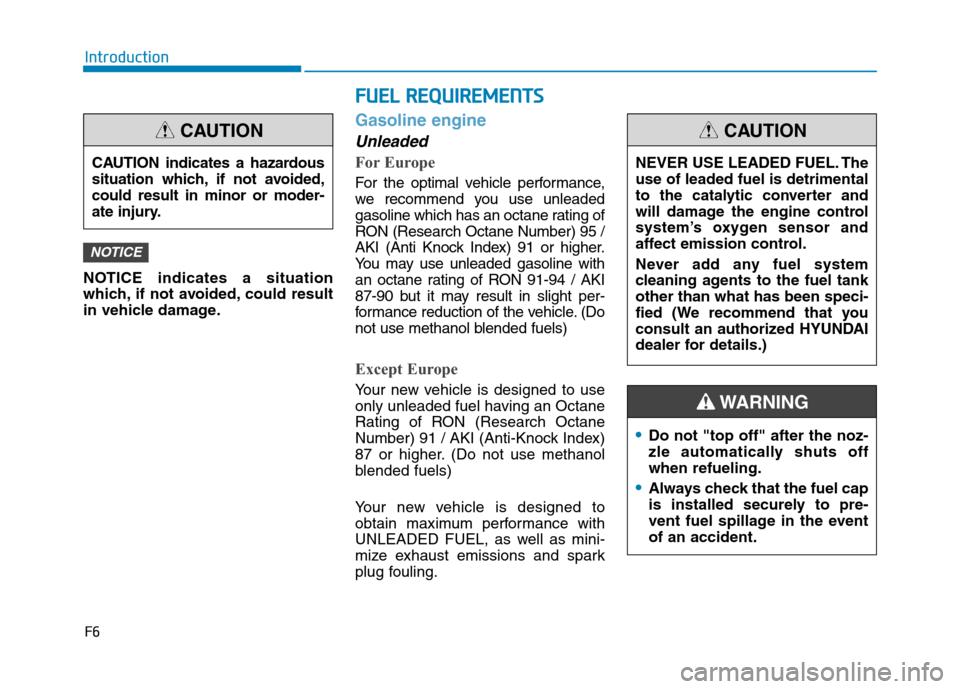
F6
Introduction
NOTICE indicates a situation
which, if not avoided, could result
in vehicle damage.
Gasoline engine
Unleaded
For Europe
For the optimal vehicle performance,
we recommend you use unleaded
gasoline which has an octane rating of
RON (Research Octane Number) 95 /
AKI (Anti Knock Index) 91 or higher.
You may use unleaded gasoline with
an octane rating of RON 91-94 / AKI
87-90 but it may result in slight per-
formance reduction of the vehicle. (Do
not use methanol blended fuels)
Except Europe
Your new vehicle is designed to use
only unleaded fuel having an Octane
Rating of RON (Research Octane
Number) 91 / AKI (Anti-Knock Index)
87 or higher. (Do not use methanol
blended fuels)
Your new vehicle is designed to
obtain maximum performance with
UNLEADED FUEL, as well as mini-
mize exhaust emissions and spark
plug fouling.
NOTICE
•Do not "top off" after the noz-
zle automatically shuts off
when refueling.
Always check that the fuel cap
is installed securely to pre-
vent fuel spillage in the event
of an accident.
WARNING
NEVER USE LEADED FUEL. The
use of leaded fuel is detrimental
to the catalytic converter and
will damage the engine control
system’s oxygen sensor and
affect emission control.
Never add any fuel system
cleaning agents to the fuel tank
other than what has been speci-
fied (We recommend that you
consult an authorized HYUNDAI
dealer for details.)
CAUTION
CAUTION indicates a hazardous
situation which, if not avoided,
could result in minor or moder-
ate injury.
CAUTION
F FU
UE
EL
L
R
RE
EQ
QU
UI
IR
RE
EM
ME
EN
NT
TS
S
Page 19 of 637
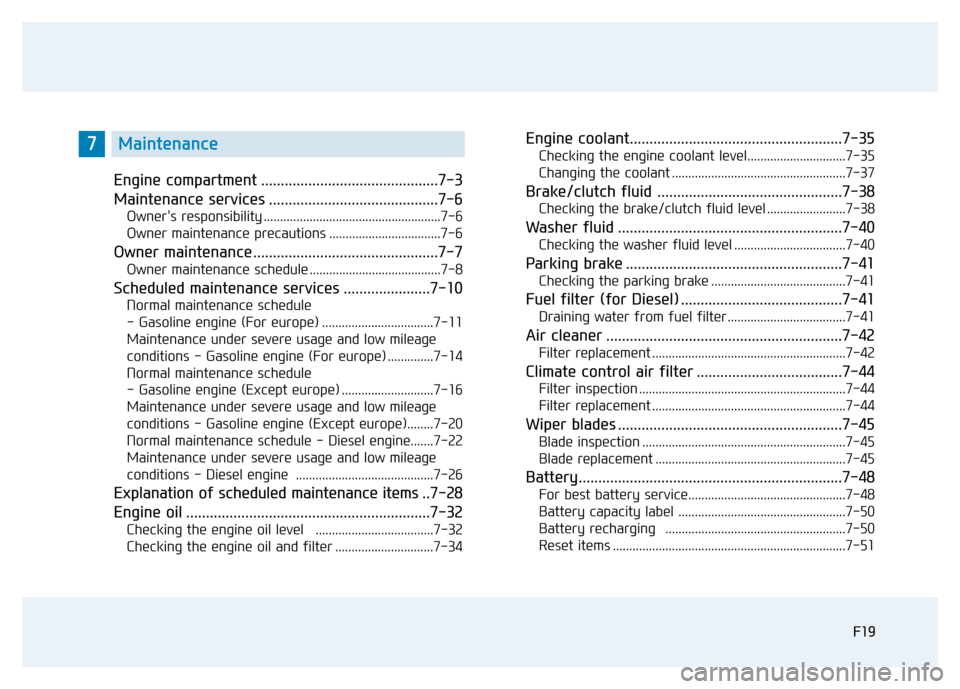
F19
Engine compartment .............................................7-3
Maintenance services ...........................................7-6
Owner's responsibility ......................................................7-6
Owner maintenance precautions ..................................7-6
Owner maintenance ...............................................7-7
Owner maintenance schedule ........................................7-8
Scheduled maintenance services ......................7-10
Normal maintenance schedule
- Gasoline engine (For europe) ..................................7-11
Maintenance under severe usage and low mileage
conditions - Gasoline engine (For europe) ..............7-14
Normal maintenance schedule
- Gasoline engine (Except europe) ............................7-16
Maintenance under severe usage and low mileage
conditions - Gasoline engine (Except europe)........7-20
Normal maintenance schedule - Diesel engine.......7-22
Maintenance under severe usage and low mileage
conditions - Diesel engine ..........................................7-26
Explanation of scheduled maintenance items ..7-28
Engine oil ..............................................................7-32
Checking the engine oil level ....................................7-32
Checking the engine oil and filter ..............................7-34
Engine coolant......................................................7-35
Checking the engine coolant level..............................7-35
Changing the coolant .....................................................7-37
Brake/clutch fluid ...............................................7-38
Checking the brake/clutch fluid level ........................7-38
Washer fluid .........................................................7-40
Checking the washer fluid level ..................................7-40
Parking brake .......................................................7-41
Checking the parking brake .........................................7-41
Fuel filter (for Diesel) .........................................7-41
Draining water from fuel filter ....................................7-41
Air cleaner ............................................................7-42
Filter replacement ...........................................................7-42
Climate control air filter .....................................7-44
Filter inspection ...............................................................7-44
Filter replacement ...........................................................7-44
Wiper blades .........................................................7-45
Blade inspection ..............................................................7-45
Blade replacement ..........................................................7-45
Battery...................................................................7-48
For best battery service................................................7-48
Battery capacity label ...................................................7-50
Battery recharging .......................................................7-50
Reset items .......................................................................7-51
F19
7Maintenance
Page 143 of 637
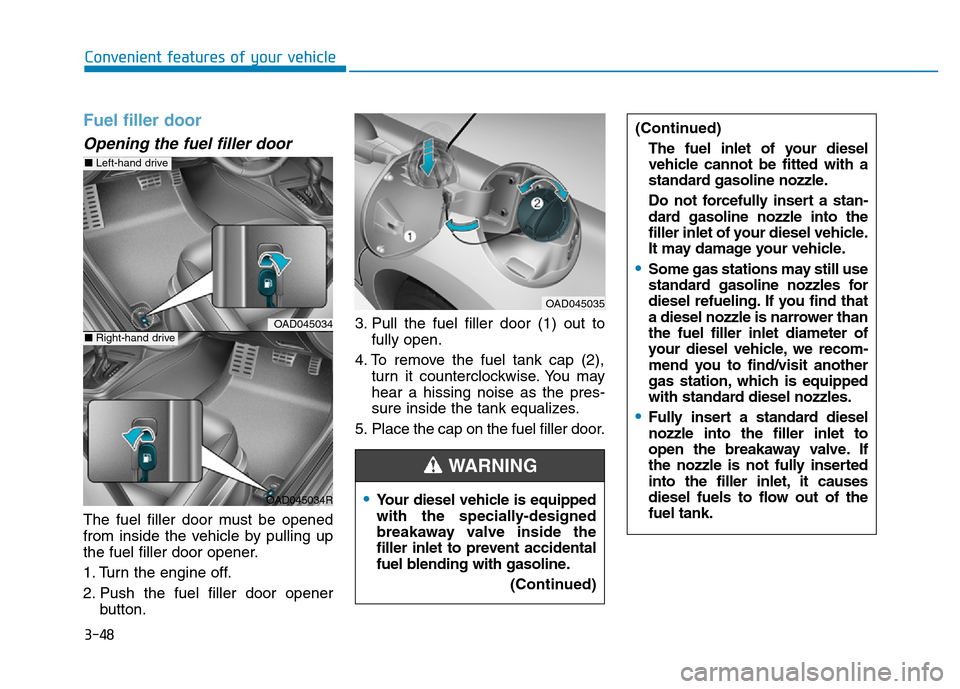
3-48
Convenient features of your vehicle
Fuel filler door
Opening the fuel filler door
The fuel filler door must be opened
from inside the vehicle by pulling up
the fuel filler door opener.
1. Turn the engine off.
2. Push the fuel filler door opener
button.3. Pull the fuel filler door (1) out to
fully open.
4. To remove the fuel tank cap (2),
turn it counterclockwise. You may
hear a hissing noise as the pres-
sure inside the tank equalizes.
5. Place the cap on the fuel filler door.
OAD045034
OAD045034R
■Left-hand drive
■Right-hand drive
OAD045035
(Continued)
The fuel inlet of your diesel
vehicle cannot be fitted with a
standard gasoline nozzle.
Do not forcefully insert a stan-
dard gasoline nozzle into the
filler inlet of your diesel vehicle.
It may damage your vehicle.
•Some gas stations may still use
standard gasoline nozzles for
diesel refueling. If you find that
a diesel nozzle is narrower than
the fuel filler inlet diameter of
your diesel vehicle, we recom-
mend you to find/visit another
gas station, which is equipped
with standard diesel nozzles.
•Fully insert a standard diesel
nozzle into the filler inlet to
open the breakaway valve. If
the nozzle is not fully inserted
into the filler inlet, it causes
diesel fuels to flow out of the
fuel tank.
•Your diesel vehicle is equipped
with the specially-designed
breakaway valve inside the
filler inlet to prevent accidental
fuel blending with gasoline.
(Continued)
WARNING
Page 144 of 637
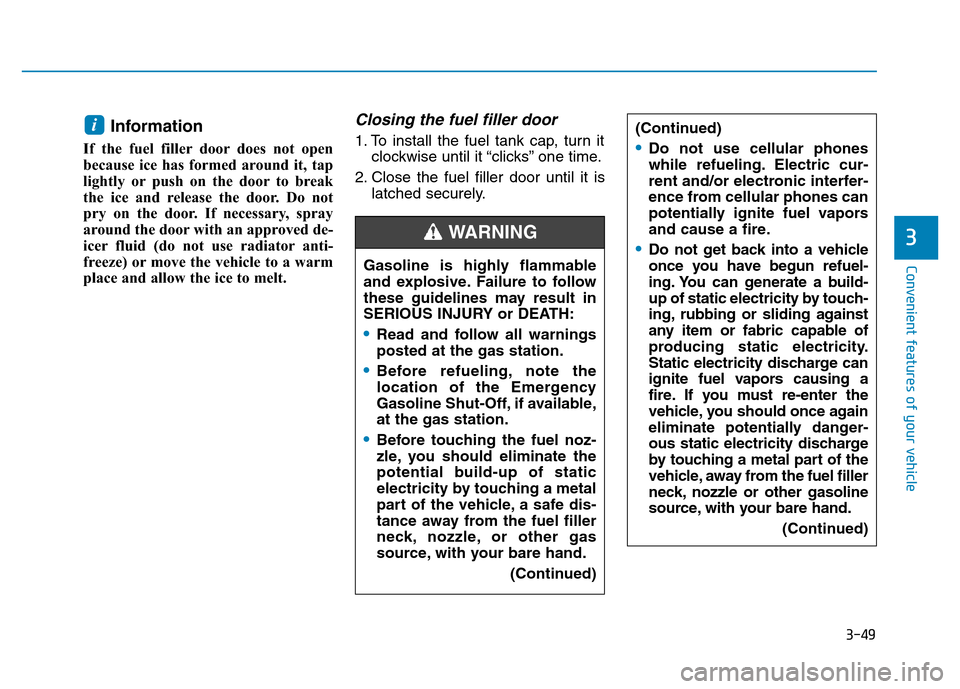
3-49
Convenient features of your vehicle
3
Information
If the fuel filler door does not open
because ice has formed around it, tap
lightly or push on the door to break
the ice and release the door. Do not
pry on the door. If necessary, spray
around the door with an approved de-
icer fluid (do not use radiator anti-
freeze) or move the vehicle to a warm
place and allow the ice to melt.
Closing the fuel filler door
1. To install the fuel tank cap, turn it
clockwise until it “clicks” one time.
2. Close the fuel filler door until it is
latched securely.i
Gasoline is highly flammable
and explosive. Failure to follow
these guidelines may result in
SERIOUS INJURY or DEATH:
•Read and follow all warnings
posted at the gas station.
•Before refueling, note the
location of the Emergency
Gasoline Shut-Off, if available,
at the gas station.
•Before touching the fuel noz-
zle, you should eliminate the
potential build-up of static
electricity by touching a metal
part of the vehicle, a safe dis-
tance away from the fuel filler
neck, nozzle, or other gas
source, with your bare hand.
(Continued)
WARNING
(Continued)
•Do not use cellular phones
while refueling. Electric cur-
rent and/or electronic interfer-
ence from cellular phones can
potentially ignite fuel vapors
and cause a fire.
•Do not get back into a vehicle
once you have begun refuel-
ing. You can generate a build-
up of static electricity by touch-
ing, rubbing or sliding against
any item or fabric capable of
producing static electricity.
Static electricity discharge can
ignite fuel vapors causing a
fire. If you must re-enter the
vehicle, you should once again
eliminate potentially danger-
ous static electricity discharge
by touching a metal part of the
vehicle, away from the fuel filler
neck, nozzle or other gasoline
source, with your bare hand.
(Continued)
Page 145 of 637
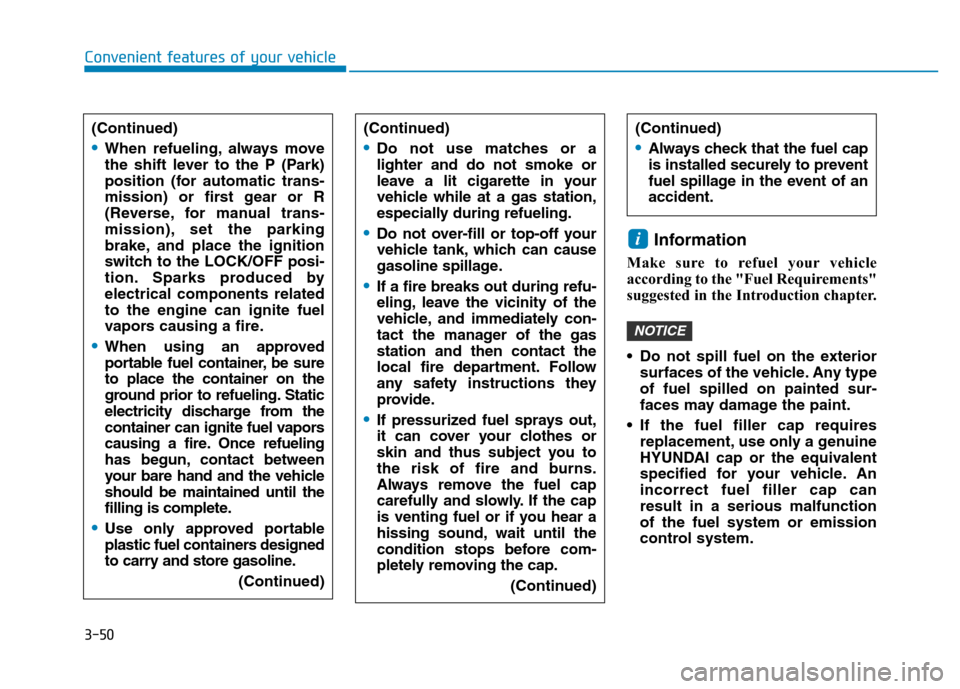
3-50
Convenient features of your vehicle
Information
Make sure to refuel your vehicle
according to the "Fuel Requirements"
suggested in the Introduction chapter.
• Do not spill fuel on the exterior
surfaces of the vehicle. Any type
of fuel spilled on painted sur-
faces may damage the paint.
• If the fuel filler cap requires
replacement, use only a genuine
HYUNDAI cap or the equivalent
specified for your vehicle. An
incorrect fuel filler cap can
result in a serious malfunction
of the fuel system or emission
control system.
NOTICE
i
(Continued)
•Do not use matches or a
lighter and do not smoke or
leave a lit cigarette in your
vehicle while at a gas station,
especially during refueling.
•Do not over-fill or top-off your
vehicle tank, which can cause
gasoline spillage.
•If a fire breaks out during refu-
eling, leave the vicinity of the
vehicle, and immediately con-
tact the manager of the gas
station and then contact the
local fire department. Follow
any safety instructions they
provide.
•If pressurized fuel sprays out,
it can cover your clothes or
skin and thus subject you to
the risk of fire and burns.
Always remove the fuel cap
carefully and slowly. If the cap
is venting fuel or if you hear a
hissing sound, wait until the
condition stops before com-
pletely removing the cap.
(Continued)
(Continued)
•Always check that the fuel cap
is installed securely to prevent
fuel spillage in the event of an
accident.
(Continued)
•When refueling, always move
the shift lever to the P (Park)
position (for automatic trans-
mission) or first gear or R
(Reverse, for manual trans-
mission), set the parking
brake, and place the ignition
switch to the LOCK/OFF posi-
tion. Sparks produced by
electrical components related
to the engine can ignite fuel
vapors causing a fire.
•When using an approved
portable fuel container, be sure
to place the container on the
ground prior to refueling. Static
electricity discharge from the
container can ignite fuel vapors
causing a fire. Once refueling
has begun, contact between
your bare hand and the vehicle
should be maintained until the
filling is complete.
•Use only approved portable
plastic fuel containers designed
to carry and store gasoline.
(Continued)
Page 150 of 637
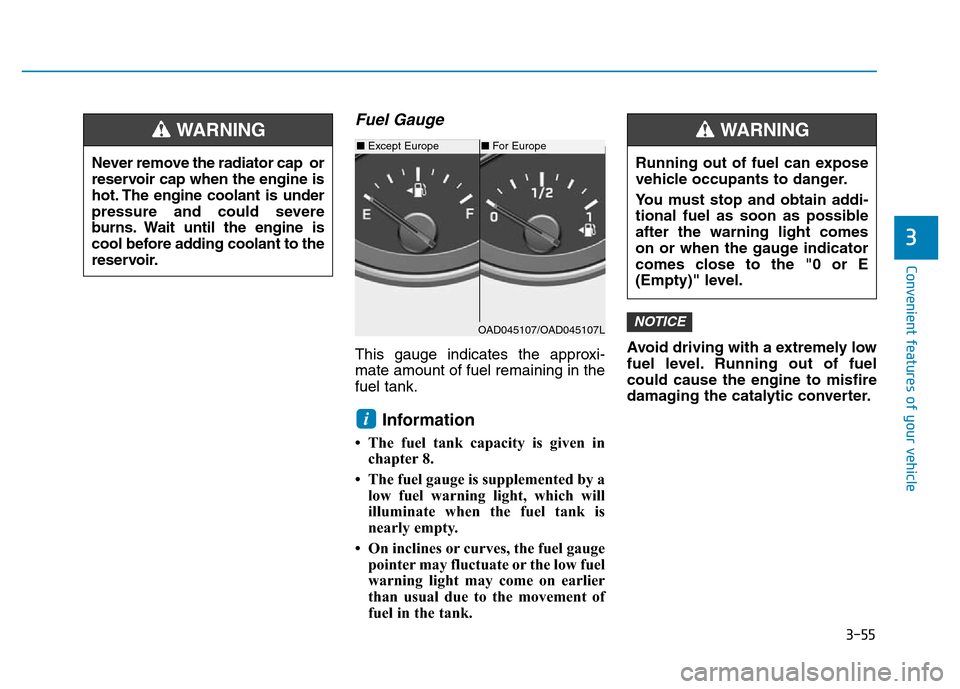
3-55
Convenient features of your vehicle
3
Fuel Gauge
This gauge indicates the approxi-
mate amount of fuel remaining in the
fuel tank.
Information
• The fuel tank capacity is given in
chapter 8.
• The fuel gauge is supplemented by a
low fuel warning light, which will
illuminate when the fuel tank is
nearly empty.
• On inclines or curves, the fuel gauge
pointer may fluctuate or the low fuel
warning light may come on earlier
than usual due to the movement of
fuel in the tank.Avoid driving with a extremely low
fuel level. Running out of fuel
could cause the engine to misfire
damaging the catalytic converter.
NOTICE
i
Never remove the radiator cap or
reservoir cap when the engine is
hot. The engine coolant is under
pressure and could severe
burns. Wait until the engine is
cool before adding coolant to the
reservoir.
WARNING
Running out of fuel can expose
vehicle occupants to danger.
You must stop and obtain addi-
tional fuel as soon as possible
after the warning light comes
on or when the gauge indicator
comes close to the "0 or E
(Empty)" level.
WARNING
OAD045107/OAD045107L
■Except Europe■For Europe
Page 512 of 637
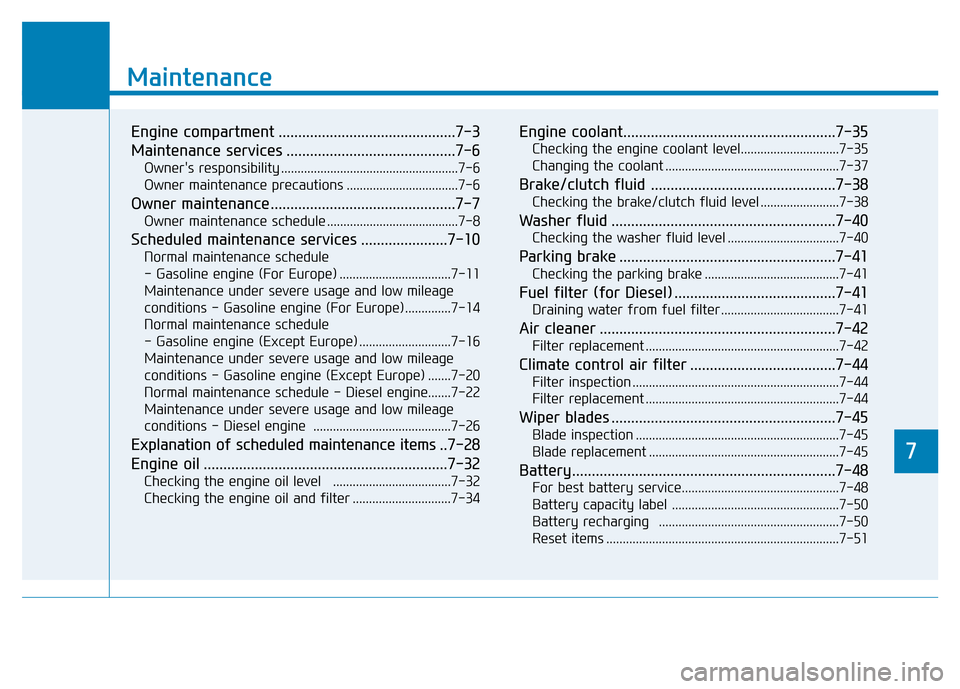
7
Maintenance
7
Maintenance
Engine compartment .............................................7-3
Maintenance services ...........................................7-6
Owner's responsibility ......................................................7-6
Owner maintenance precautions ..................................7-6
Owner maintenance ...............................................7-7
Owner maintenance schedule ........................................7-8
Scheduled maintenance services ......................7-10
Normal maintenance schedule
- Gasoline engine (For Europe) ..................................7-11
Maintenance under severe usage and low mileage
conditions - Gasoline engine (For Europe) ..............7-14
Normal maintenance schedule
- Gasoline engine (Except Europe) ............................7-16
Maintenance under severe usage and low mileage
conditions - Gasoline engine (Except Europe) .......7-20
Normal maintenance schedule - Diesel engine.......7-22
Maintenance under severe usage and low mileage
conditions - Diesel engine ..........................................7-26
Explanation of scheduled maintenance items ..7-28
Engine oil ..............................................................7-32
Checking the engine oil level ....................................7-32
Checking the engine oil and filter ..............................7-34
Engine coolant......................................................7-35
Checking the engine coolant level..............................7-35
Changing the coolant .....................................................7-37
Brake/clutch fluid ...............................................7-38
Checking the brake/clutch fluid level ........................7-38
Washer fluid .........................................................7-40
Checking the washer fluid level ..................................7-40
Parking brake .......................................................7-41
Checking the parking brake .........................................7-41
Fuel filter (for Diesel) .........................................7-41
Draining water from fuel filter ....................................7-41
Air cleaner ............................................................7-42
Filter replacement ...........................................................7-42
Climate control air filter .....................................7-44
Filter inspection ...............................................................7-44
Filter replacement ...........................................................7-44
Wiper blades .........................................................7-45
Blade inspection ..............................................................7-45
Blade replacement ..........................................................7-45
Battery...................................................................7-48
For best battery service................................................7-48
Battery capacity label ...................................................7-50
Battery recharging .......................................................7-50
Reset items .......................................................................7-51
7
Page 522 of 637
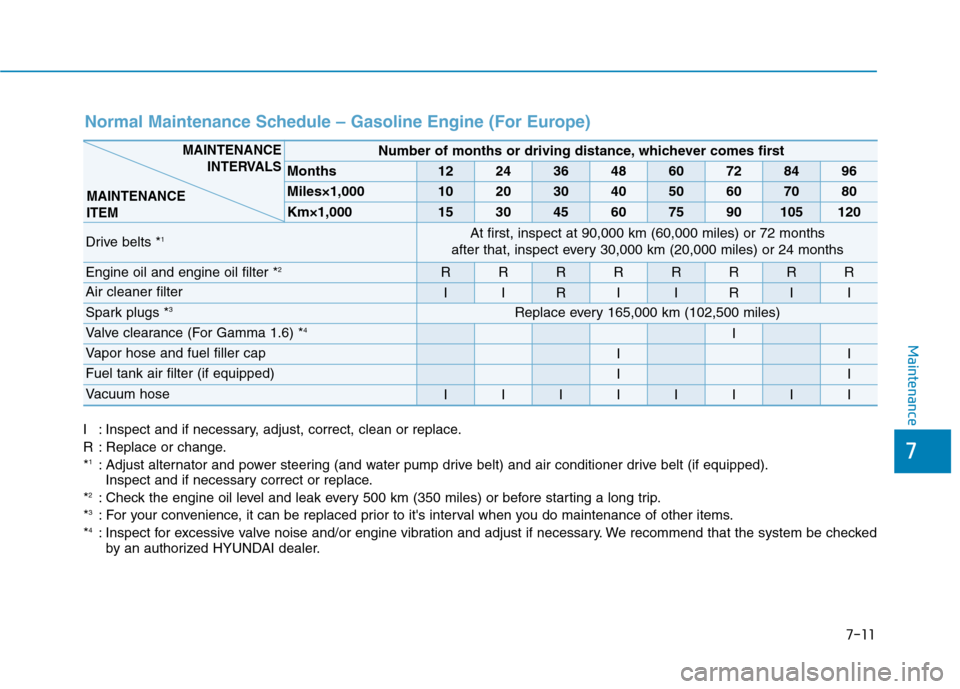
7-11
7
Maintenance
I : Inspect and if necessary, adjust, correct, clean or replace.
R : Replace or change.
*
1: Adjust alternator and power steering (and water pump drive belt) and air conditioner drive belt (if equipped).Inspect and if necessary correct or replace.
*
2: Check the engine oil level and leak every 500 km (350 miles) or before starting a long trip.
*3: For your convenience, it can be replaced prior to it's interval when you do maintenance of other items.
*4: Inspect for excessive valve noise and/or engine vibration and adjust if necessary. We recommend that the system be checked by an authorized HYUNDAI dealer.
Normal Maintenance Schedule – Gasoline Engine (For Europe)
Number of months or driving distance, whichever comes first
Months1224364860728496
Miles×1,0001020304050607080
Km×1,000153045607590105120
Drive belts *1At first, inspect at 90,000 km (60,000 miles) or 72 months
after that, inspect every 30,000 km (20,000 miles) or 24 months
Engine oil and engine oil filter *2RRRRRRRR
Air cleaner filterIIRIIRII
Spark plugs *3Replace every 165,000 km (102,500 miles)
Valve clearance (For Gamma 1.6) *4I
Vapor hose and fuel filler capII
Fuel tank air filter (if equipped)II
Vacuum hoseIIIIIIII
MAINTENANCE INTERVALS
MAINTENANCE
ITEM
Page 528 of 637

7-17
7
Maintenance
Normal Maintenance Schedule (Cont.) – Gasoline Engine (Except Europe)
I : Inspect and if necessary, adjust, correct, clean or replace.
R : Replace or change.
*
5: For your convenience, it can be replaced prior to it's interval when you do maintenance of other items.
*6: Inspect for excessive valve noise and/or engine vibration and adjust if necessary. We recommend that the system be checked by an authorized HYUNDAI dealer.
*
7: The fuel filter is considered to be maintenance free but periodic inspection is recommended for this maintenance schedule depends on fuel quality. If there are some important matters like fuel flow restriction, surging, loss of power, hard starting p roblem
etc, we recommend replacing the fuel filter immediately regardless of maintena\
nce schedule and consulting with an authorized
HYUNDAI dealer for details.
Number of months or driving distance, whichever comes first
Months1224364860728496
Miles×1,0001020304050607080
Km×1,000153045607590105120
Spark plugs *5Replace every 165,000 km (102,500 miles)
Valve clearance *6 (For Gamma 1.6)I
Vapor hose and fuel filler capII
Fuel tank air filter (if equipped)IRIR
Vacuum hoseIIIIIIII
Fuel filter *7IRIR
Fuel lines, hoses and connectionsII
MAINTENANCE INTERVALS
MAINTENANCE
ITEM
Page 533 of 637

Maintenance
7-22
I : Inspect and if necessary, adjust, correct, clean or replace.
R : Replace or change.
*
1: Inspect and if necessary correct or replace. Inspect drive belt tensioner, idler and alternator pulley and if necessary correct or
replace.
*
2: Check the engine oil level and leak every 500 km (350 miles) or before starting a long trip.
*3: The engine oil level should be checked regularly and maintained properly. Operating with an insufficient amount oil can dam- age the engine, and such damage is not covered by warranty.
Normal Maintenance Schedule – Diesel Engine
Number of months or driving distance, whichever comes first
Months1224364860728496
Miles×1,00012.52537.55062.57587.5100
Km×1,00020406080100120140160
Drive belts *1At first, inspect at 80,000 km (50,000 miles) or 48 months, after every 20,000 km (12,500 miles) or 12 months
Engine oil and engine oil filter *2*3RRRRRRRR
Tensioner/idler/damper pulleyInspect when replacing the drive belt
Air cleaner filter IRIRIRIR
Fuel filler capII
MAINTENANCE INTERVALS
MAINTENANCE
ITEM